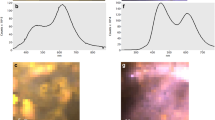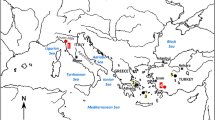Abstract
OPTICAL and electron paramagnetic resonance (EPR) properties of natural and synthetic calcite (limestone, CaCO3) have been studied extensively and it is known that ionising radiation in the form of cosmic rays or from radioactive elements introduces defects such as CO3− (a hole centre) and CO33− (an electron centre), which are stabilised by impurities to form sources of thermoluminescence1,2. There are four thermal glow peaks above room temperature3,4, some of which can be used to trace the history of calcite5. Here I report the presence of a radiation-induced defect in the growing stalactites of Japan's main calcite caverns and show that estimation of the accumulated defect concentration at several positions, using EPR, makes it possible to determine the age and growth rate of a stalactite.
This is a preview of subscription content, access via your institution
Access options
Subscribe to this journal
Receive 51 print issues and online access
$199.00 per year
only $3.90 per issue
Buy this article
- Purchase on Springer Link
- Instant access to full article PDF
Prices may be subject to local taxes which are calculated during checkout
Similar content being viewed by others
References
Serway, R. A., and Marshall, S. A., J. chem. Phys., 46, 1949 (1967).
Marshall, S. A., McMillian, J. A., and Serway, R. A., J. chem. Phys., 48, 5131 (1968).
Meldin, W. L., Phys. Rev. A, 135, 1770 (1964).
Thermoluminescence of Geological Materials (edit. by McDougall, D. J.), ch. 3.1,91 and ch. 4.1,193 (Academic, London, 1968).
Zeller, E. J., in Thermoluminescence of Geological Materials (edit. by McDougall, D. J.), chapter 5.1, 271 and chapter 6.1 (Academic, London, 1968).
Mamet, B. L., and Dalbissin, M., Carbonate Rocks, Developments in Sedimentoloty 9B (edit. by Chilingar, G. V., Bissell, H. J., and Fairbridge, R. W.), chapter 4 (Elsevier, Amsterdam, 1965).
Debenedetti, A., Nuovo Cim, 7, 251 (1958).
Yamagata, N., and Iwashima, K., Health Phys., 13, 1145 (1967).
Aitken, M. J., in Thermoluminescence of Geological Materials (edit. by McDougall, D. J.), chapter 7.1, 369 (Academic, London, 1968).
Research Methods in Pleistocene Geomorphology (edit. by Yatsu, and Falconer, 247 (Second Guelph Symposium 1971).
Author information
Authors and Affiliations
Rights and permissions
About this article
Cite this article
IKEYA, M. Dating a stalactite by electron paramagnetic resonance. Nature 255, 48–50 (1975). https://doi.org/10.1038/255048a0
Received:
Accepted:
Issue Date:
DOI: https://doi.org/10.1038/255048a0
This article is cited by
-
Glacial advances and ESR chronology of the Pochengzi Glaciation, Tianshan Mountains, China
Science China Earth Sciences (2010)
-
A ~30,000-year record of environmental changes inferred from Lake Chen Co, Southern Tibet
Journal of Paleolimnology (2009)
-
Quaternary evolution of the Gulf of İzmit (NW Turkey): a sedimentary basin under control of the North Anatolian Fault Zone
Geo-Marine Letters (2007)
Comments
By submitting a comment you agree to abide by our Terms and Community Guidelines. If you find something abusive or that does not comply with our terms or guidelines please flag it as inappropriate.



